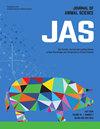A comparison of fatty acid percentages and mass, sensory attributes, and volatile aroma compounds for segregating beef quality grades
IF 2.7
2区 农林科学
Q1 AGRICULTURE, DAIRY & ANIMAL SCIENCE
引用次数: 0
Abstract
We hypothesized that combining sensory flavor attributes, volatile aroma compounds (VAC), and fatty acid composition would better separate beef quality grades than fatty acid composition alone. Select, Choice, Prime, and Grass-fed ribeye rolls (n = 6 per group) were purchased from a local distributor, so production conditions or cattle type were unknown. Select cooked beef steaks ranked lowest for Beef Flavor, Bloody/Serumy, Brown/Roasted, and Umami (P ≤ 0.048). Prime steaks had greater values than other steak types for the VAC 2-methyl-butanal, 2-methyl-propanal (2MP), 3-methyl-butanal (3MB), and 3-hydroxy-2-butanone (3H2B) (P ≤ 0.025). There was a significant, positive correlation of 3MB and 3H2B with Beef Flavor (P ≤ 0.05), and 2MB, 3MB, and 2MP were significantly, positively correlated with Brown/Roasted (P ≤ 0.05). Principal component analysis (PCA) that included fatty acid percentages indicated that all positive flavor attributes clustered with 2MP and 3H2P, Grass-fed, and Prime. A PCA analysis that included mg fatty acid/100 g muscle (i.e., fatty acid mass) segregated all positive flavor attributes and all fatty acids with Grass-fed and Prime steaks, but VAC were not in the same quadrant. Fatty acid percentages, sensory attributes, and VAC were analyzed by partial least squares regression discriminant analysis (PLS-DA), and Grass-fed and Select clustered closely and Prime and Choice clustered separately. Analysis by PLS-DA fatty acid mass, sensory attributes, and VAC indicated that all beef types were distinctly separated. We conclude that including fatty acid composition with sensory attributes and VAC better separates beef quality types than fatty acid composition alone.比较脂肪酸的百分比和质量,感官属性,和挥发性香气化合物分离牛肉品质等级
我们假设将感官风味属性、挥发性香气化合物(VAC)和脂肪酸组成结合起来比单独的脂肪酸组成更能区分牛肉的品质等级。Select, Choice, Prime和草饲肋眼卷(每组n = 6)从当地经销商处购买,因此生产条件或牛类型未知。牛肉风味、血色/血清色、棕色/烤色和鲜味排名最低的选择熟牛排(P≤0.048)。上等牛排中2-甲基丁醛、2-甲基丙烷(2MP)、3-甲基丁醛(3MB)和3-羟基-2-丁酮(3H2B)的VAC值高于其他牛排(P≤0.025)。3MB、3H2B与牛肉风味呈显著正相关(P≤0.05),2MB、3MB、2MP与Brown/ roast呈显著正相关(P≤0.05)。包括脂肪酸百分比在内的主成分分析(PCA)表明,所有阳性风味属性都聚集在2MP和3H2P、草饲和Prime上。含mg脂肪酸/100 g肌肉(即脂肪酸质量)的PCA分析分离出草饲和优质牛排的所有正风味属性和所有脂肪酸,但VAC不在同一象限。采用偏最小二乘回归判别分析(PLS-DA)对脂肪酸百分比、感官属性和VAC进行分析,草饲和Select紧密聚类,Prime和Choice单独聚类。PLS-DA脂肪酸质量、感官属性和VAC分析表明,所有牛肉类型都有明显的分离。我们得出结论,包括具有感官属性的脂肪酸组成和VAC比单独的脂肪酸组成更能区分牛肉品质类型。
本文章由计算机程序翻译,如有差异,请以英文原文为准。
求助全文
约1分钟内获得全文
求助全文
来源期刊

Journal of animal science
农林科学-奶制品与动物科学
CiteScore
4.80
自引率
12.10%
发文量
1589
审稿时长
3 months
期刊介绍:
The Journal of Animal Science (JAS) is the premier journal for animal science and serves as the leading source of new knowledge and perspective in this area. JAS publishes more than 500 fully reviewed research articles, invited reviews, technical notes, and letters to the editor each year.
Articles published in JAS encompass a broad range of research topics in animal production and fundamental aspects of genetics, nutrition, physiology, and preparation and utilization of animal products. Articles typically report research with beef cattle, companion animals, goats, horses, pigs, and sheep; however, studies involving other farm animals, aquatic and wildlife species, and laboratory animal species that address fundamental questions related to livestock and companion animal biology will be considered for publication.
 求助内容:
求助内容: 应助结果提醒方式:
应助结果提醒方式:


